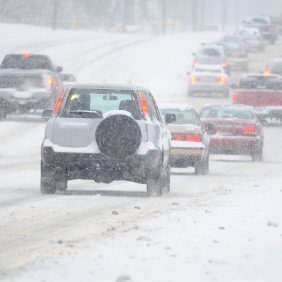As a Wisconsin winter driver you cannot control the weather, which ultimately leads to less than desirable driving conditions, but you 
- Clear snow and ice from all windows and lights – even the hood and roof – before driving.
- Always have your headlights on when it is snowing or sleeting.
- Pay attention. Don’t try to out-drive the conditions. Remember the posted speed limits are for dry pavement.
- Leave plenty of room for stopping.
- Leave room for maintenance vehicles and plows. The law requires you to slow down or move over when approaching emergency or maintenance vehicles, including snowplows, parked on the side of the road when they have their flashing lights turned on. If you approach a parked emergency or maintenance vehicle during a winter storm and decide to change lanes be extra careful. The passing lane may be in worse shape than the driving lane. There may also be a snow ridge between the two lanes. Avoid making an abrupt lane change. If approaching a snowplow, stay back at least 200 feet (it’s the law!), and don’t pass on the right.
- Don’t use your cruise control in wintry conditions. Even roads that appear clear can have sudden slippery spots and the short touch of your brakes to deactivate the cruise control feature can cause you to lose control of your vehicle.
- Use brakes carefully. Brake early. Brake correctly. It takes more time and distance to stop in adverse conditions.Whether you have anti-lock brakes or not, the best way to stop is threshold breaking. Keep the heel of your foot on the floor and use the ball of your foot to apply firm, steady pressure on the brake pedal.
- Watch for slippery bridge decks, even when the rest of the pavement is in good condition. Bridge decks will ice up sooner than the adjacent pavement.
- Don’t get overconfident in your 4×4 vehicle. Remember that your four-wheel drive vehicle may help you get going quicker than other vehicles but it won’t help you stop any faster. Many 4×4 vehicles are heavier than passenger vehicles and actually may take longer to stop. Don’t get overconfident, your 4×4 can lose traction as quickly as a two-wheel drive vehicle.
- Look farther ahead in traffic than you normally do. Actions by cars and trucks will alert you quicker to problems and give you a split-second extra time to react safely.
- Remember that trucks are heavier than cars. Trucks take longer to safely respond and come to a complete stop, so avoid cutting quickly in front of them.
- If skidding, remain calm, ease foot off the gas, and turn the steering wheel in the direction you want the front of the vehicle to go.
- Keep a supply box in your car. While it might sound obvious that you should have winter preparedness items in your car, you might not think to keep some of these items on hand.
– Flashlight
– Flares
– Blankets
– Warm clothing
– Extra gloves
– Materials for traction (sand or kitty litter)
– Charged cell phone (to call 911)
– Snow brush and ice scraper
– Snacks
- Go slow!
- Always keep up on any maintenance needed on your vehicle. This includes, but is not limited to, tires, oil changes, spark plugs, hoses, belts, and water pumps. It is ideal to do a seasonal check up. This is something many companies can do while they change your oil.
Please be safe!




